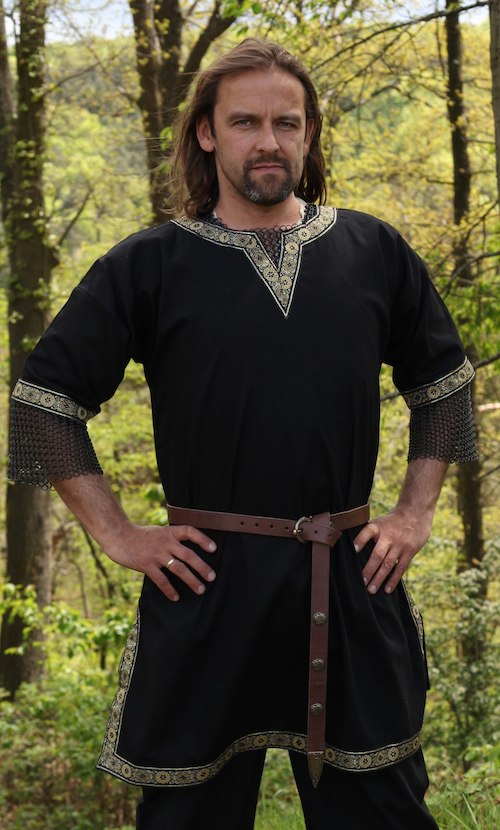Tabard and tunic: Who does your warrior's heart beat for?
 Along with armour, the tunic is part of a medieval knight's basic equipment. In the heat of battle, it was difficult to tell friend from foe by their armour alone. So wear a tabard with your crest or the crest of your allies. It will show for whom your fighting heart beats. You will always be easily recognisable to your comrades and fellow LARPers. You will proudly represent your clan, your knightly order or your viking mob and fight alongside your comrades-in-arms. In our range you will find a variety of medieval tunics. You can customise each tunic at home with your coat of arms:
Along with armour, the tunic is part of a medieval knight's basic equipment. In the heat of battle, it was difficult to tell friend from foe by their armour alone. So wear a tabard with your crest or the crest of your allies. It will show for whom your fighting heart beats. You will always be easily recognisable to your comrades and fellow LARPers. You will proudly represent your clan, your knightly order or your viking mob and fight alongside your comrades-in-arms. In our range you will find a variety of medieval tunics. You can customise each tunic at home with your coat of arms:
- Plain tunic
- Two-tone tunic
- Chequered tunic
- Templar tabard
- Embroidered tabard
The simple medieval tunic is ideal for adding your own embroidery. The pre-embroidered options give you a simple but effective way to complete your garb and armour. We have the right tunic for you. Model your character after the Crusaders or Templars of the Middle Ages. Choose from Tolkien's Riders of Rohan, Aslan's Warrior from Narnia or your own idea.
The medieval tunic in many colour combinations
Every LARP group, clan and Viking community has its own medieval or fantasy colours. That is why our medieval tabards are available in many different colours and colour combinations. Red, green, black or grey, choose the colour that suits you best. Warriors and fighters can show their loyalty in battle with their tunic. The choice of colour is up to you, whether natural and plain, two-piece or checked. Most of our tunics are made from cotton. But you can also find tunics in linen, cotton velvet or wool. So you are perfectly equipped for every season. Our men's tabards are made in one size. However, we have left them partially open or slit at the sides so that they can be easily pulled over the armour and belted. Our medieval tunics will fit any warrior, viking or knight. It doesn't matter if you're tall or short, big or small. If the tunic is a little too long for you, or you need special adjustments, you can easily alter it. The important thing is that it suits your character.
Tabard and tunic: medieval clothing for commoners and nobility
 In the Middle Ages, a tabard was mainly used as outer clothing for the fighting guilds. The tunic in the Middle Ages was a simple garment that could be combined with almost any outfit in a LARP. A tunic is just as suitable for a Viking as it is for a simple lad. It can be worn on top or underneath. It is no coincidence that the tunic remained in fashion throughout the Middle Ages. In the harsh northern as well as in the Mediterranean climates, the tunic was one of the most popular items of clothing for all social classes, along with shirts and trousers.
In the Middle Ages, a tabard was mainly used as outer clothing for the fighting guilds. The tunic in the Middle Ages was a simple garment that could be combined with almost any outfit in a LARP. A tunic is just as suitable for a Viking as it is for a simple lad. It can be worn on top or underneath. It is no coincidence that the tunic remained in fashion throughout the Middle Ages. In the harsh northern as well as in the Mediterranean climates, the tunic was one of the most popular items of clothing for all social classes, along with shirts and trousers.
With the tunic in natural, green, red or black, there were no limits to the wearer's status in the Middle Ages. This also applies to the type of embroidery. A tunic is particularly beautiful when it has lovingly woven borders. With their striking appearance, these borders can make even a simple tunic stand out as a garment. Arms skirts for the aristocracy can be embellished and designed to suit individual requirements. The more opulent and richly decorated the tabard or tunic, the higher the status of the character in the Middle Ages.
Medieval tabards and tunics at LARP-Fashion.co.uk
Discover our selected range of medieval tabards and tunics for men and women. We focus on quality with all our products for shipping. You can expect each of our items to be made from high quality materials and well finished. With proper and loving care, our products will last you a long time. Take them with you on your adventures at various cons and events. This applies to all products of LARP-Fashion.co.uk. This applies to customised leather armour as well as medieval shoes, medieval shirts and medieval clothing in general. Do you have any questions about our range of tabards, tunics or other clothing?
Would you like to create a new character with a medieval tunic, but are not sure which garment is best for you? Please contact us for all such information. We are always available via our hotline or you can simply use our contact form.
Your contact with us